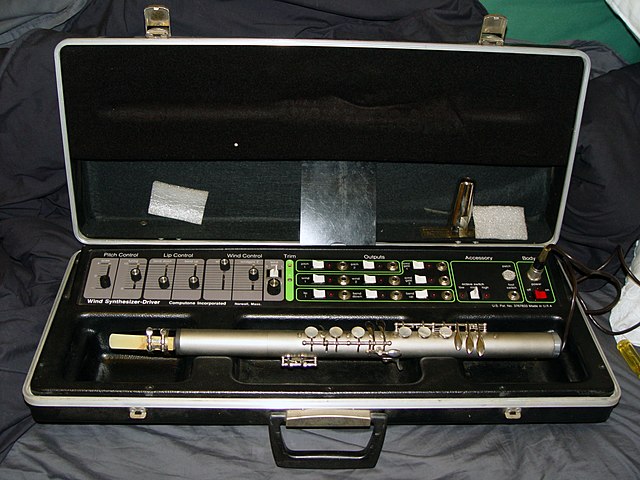A wind controller, sometimes referred to as a wind synthesizer, is an electronic wind instrument. It is usually a MIDI controller associated with one or more music synthesizers. Wind controllers are most commonly played and fingered like a woodwind instrument, usually the saxophone, with the next most common being brass fingering, particularly the trumpet. Models have been produced that play and finger like other acoustic instruments such as the recorder or the tin whistle. The most common form of wind controller uses electronic sensors to convert fingering, breath pressure, bite pressure, finger pressure, and other gesture or action information into control signals that affect musical sounds. The control signals or MIDI messages generated by the wind controller are used to control internal or external devices such as analog synthesizers or MIDI-compatible synthesizers, synth modules, softsynths, sequencers, or even non-instruments such as lighting systems.

San Francisco musician Onyx Ashanti playing a wind controller
Computone Wind Synthesizer Controller (essentially, Lyricon II without synthesizer)
A MIDI controller is any hardware or software that generates and transmits Musical Instrument Digital Interface (MIDI) data to MIDI-enabled devices, typically to trigger sounds and control parameters of an electronic music performance. They most often use a musical keyboard to send data about the pitch of notes to play, although a MIDI controller may trigger lighting and other effects. A wind controller has a sensor that converts breath pressure to volume information and lip pressure to control pitch. Controllers for percussion and stringed instruments exist, as well as specialized and experimental devices. Some MIDI controllers are used in association with specific digital audio workstation software. The original MIDI specification has been extended to include a greater range of control features.

A Roland keytar, keyboard MIDI controller designed to be worn with a shoulder strap during performance. The keytar does not produce any musical sounds by itself. As a MIDI controller, it only sends data about which keys or buttons are pressed to a MIDI-compatible sound module or synthesizer, which then produces the sounds.
The Roland Octapad percussion/drum controller
Two-octave MIDI controllers are popular for use with laptop computers, due to their portability. This unit provides a variety of real-time controllers, which can manipulate various sound design parameters of computer-based or standalone hardware instruments, effects, mixers and recording devices.
MIDI wind controllers can produce expressive, natural-sounding performances in a way that is difficult to achieve with keyboard controllers.





